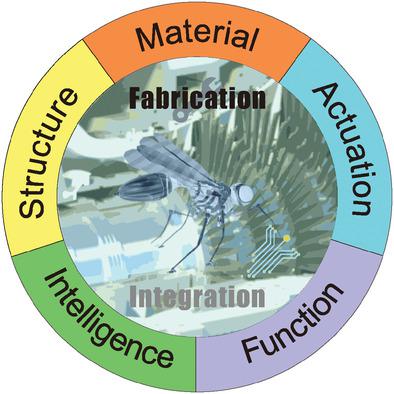当前位置:
X-MOL 学术
›
Adv. Mater.
›
论文详情
Our official English website, www.x-mol.net, welcomes your
feedback! (Note: you will need to create a separate account there.)
Fabrication and Functionality Integration Technologies for Small-Scale Soft Robots
Advanced Materials ( IF 27.4 ) Pub Date : 2022-06-22 , DOI: 10.1002/adma.202200671 Shuo Zhang 1 , Xingxing Ke 1 , Qin Jiang 1 , Zhiping Chai 1 , Zhigang Wu 1 , Han Ding 1
Advanced Materials ( IF 27.4 ) Pub Date : 2022-06-22 , DOI: 10.1002/adma.202200671 Shuo Zhang 1 , Xingxing Ke 1 , Qin Jiang 1 , Zhiping Chai 1 , Zhigang Wu 1 , Han Ding 1
Affiliation

|
Small-scale soft robots are attracting increasing interest for visible and potential applications owing to their safety and tolerance resulting from their intrinsic soft bodies or compliant structures. However, it is not sufficient that the soft bodies merely provide support or system protection. More importantly, to meet the increasing demands of controllable operation and real-time feedback in unstructured/complicated scenarios, these robots are required to perform simplex and multimodal functionalities for sensing, communicating, and interacting with external environments during large or dynamic deformation with the risk of mismatch or delamination. Challenges are encountered during fabrication and integration, including the selection and fabrication of composite/materials and structures, integration of active/passive functional modules with robust interfaces, particularly with highly deformable soft/stretchable bodies. Here, methods and strategies of fabricating structural soft bodies and integrating them with functional modules for developing small-scale soft robots are investigated. Utilizing templating, 3D printing, transfer printing, and swelling, small-scale soft robots can be endowed with several perceptual capabilities corresponding to diverse stimulus, such as light, heat, magnetism, and force. The integration of sensing and functionalities effectively enhances the agility, adaptability, and universality of soft robots when applied in various fields, including smart manufacturing, medical surgery, biomimetics, and other interdisciplinary sciences.
中文翻译:

小型软体机器人的制造与功能集成技术
小型软体机器人因其固有的软体或柔顺结构而具有安全性和耐受性,因此吸引了越来越多的可见和潜在应用的兴趣。然而,软体仅仅提供支撑或系统保护是不够的。更重要的是,为了满足非结构化/复杂场景中日益增长的可控操作和实时反馈的需求,这些机器人需要在大变形或动态变形过程中执行单一和多模态功能,以感知、通信和与外部环境交互,具有风险不匹配或分层。在制造和集成过程中遇到挑战,包括复合材料/材料和结构的选择和制造,主动/被动功能模块与坚固接口的集成,特别是高度可变形的软体/可拉伸体。在这里,研究了制造结构软体并将其与功能模块集成以开发小型软机器人的方法和策略。利用模板、3D 打印、转移打印和膨胀,小型软体机器人可以被赋予与光、热、磁和力等不同刺激相对应的多种感知能力。传感与功能的融合有效提升了软体机器人在智能制造、医疗外科、仿生学等交叉学科领域的敏捷性、适应性和普适性。在这里,研究了制造结构软体并将其与功能模块集成以开发小型软机器人的方法和策略。利用模板、3D 打印、转移打印和膨胀,小型软体机器人可以被赋予与光、热、磁和力等不同刺激相对应的多种感知能力。传感与功能的融合有效提升了软体机器人在智能制造、医疗外科、仿生学等交叉学科领域的敏捷性、适应性和普适性。在这里,研究了制造结构软体并将其与功能模块集成以开发小型软机器人的方法和策略。利用模板、3D 打印、转移打印和膨胀,小型软体机器人可以被赋予与光、热、磁和力等不同刺激相对应的多种感知能力。传感与功能的融合有效提升了软体机器人在智能制造、医疗外科、仿生学等交叉学科领域的敏捷性、适应性和普适性。转印和膨胀的小型软体机器人可以被赋予与光、热、磁和力等不同刺激相对应的几种感知能力。传感与功能的融合有效提升了软体机器人在智能制造、医疗外科、仿生学等交叉学科领域的敏捷性、适应性和普适性。转印和膨胀的小型软体机器人可以被赋予与光、热、磁和力等不同刺激相对应的几种感知能力。传感与功能的融合有效提升了软体机器人在智能制造、医疗外科、仿生学等交叉学科领域的敏捷性、适应性和普适性。
更新日期:2022-06-22
中文翻译:

小型软体机器人的制造与功能集成技术
小型软体机器人因其固有的软体或柔顺结构而具有安全性和耐受性,因此吸引了越来越多的可见和潜在应用的兴趣。然而,软体仅仅提供支撑或系统保护是不够的。更重要的是,为了满足非结构化/复杂场景中日益增长的可控操作和实时反馈的需求,这些机器人需要在大变形或动态变形过程中执行单一和多模态功能,以感知、通信和与外部环境交互,具有风险不匹配或分层。在制造和集成过程中遇到挑战,包括复合材料/材料和结构的选择和制造,主动/被动功能模块与坚固接口的集成,特别是高度可变形的软体/可拉伸体。在这里,研究了制造结构软体并将其与功能模块集成以开发小型软机器人的方法和策略。利用模板、3D 打印、转移打印和膨胀,小型软体机器人可以被赋予与光、热、磁和力等不同刺激相对应的多种感知能力。传感与功能的融合有效提升了软体机器人在智能制造、医疗外科、仿生学等交叉学科领域的敏捷性、适应性和普适性。在这里,研究了制造结构软体并将其与功能模块集成以开发小型软机器人的方法和策略。利用模板、3D 打印、转移打印和膨胀,小型软体机器人可以被赋予与光、热、磁和力等不同刺激相对应的多种感知能力。传感与功能的融合有效提升了软体机器人在智能制造、医疗外科、仿生学等交叉学科领域的敏捷性、适应性和普适性。在这里,研究了制造结构软体并将其与功能模块集成以开发小型软机器人的方法和策略。利用模板、3D 打印、转移打印和膨胀,小型软体机器人可以被赋予与光、热、磁和力等不同刺激相对应的多种感知能力。传感与功能的融合有效提升了软体机器人在智能制造、医疗外科、仿生学等交叉学科领域的敏捷性、适应性和普适性。转印和膨胀的小型软体机器人可以被赋予与光、热、磁和力等不同刺激相对应的几种感知能力。传感与功能的融合有效提升了软体机器人在智能制造、医疗外科、仿生学等交叉学科领域的敏捷性、适应性和普适性。转印和膨胀的小型软体机器人可以被赋予与光、热、磁和力等不同刺激相对应的几种感知能力。传感与功能的融合有效提升了软体机器人在智能制造、医疗外科、仿生学等交叉学科领域的敏捷性、适应性和普适性。











































 京公网安备 11010802027423号
京公网安备 11010802027423号